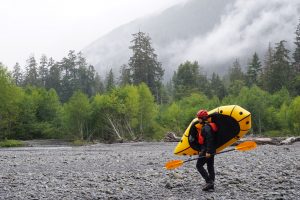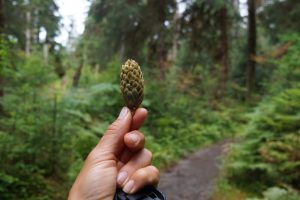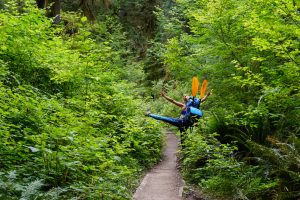Driving northwest from Mount St. Helens National Monument, we headed for the Olympic Peninsula. Upon reaching the coast and exploring a few of the beaches (Ruby beach and First Beach) in Olympic National Park, we turned inland, driving northeast until we entered the Hoh rainforest.
Leaving the sunny coastline behind, we quickly descended into dark tree cover and mist. The trees surrounding the road became increasingly dense and moss-covered. Douglas firs, normally commanding creatures adorned with sharp, broken lower branches, here seemed soft and approachable. We drove by slowly, gazing in awe and amusement at their branches, covered in lumpy protrusions of welcoming epiphytes.
The Hoh is above all stunningly green, and a mystical place of astounding quiet and calm. Making its start at the Hoh Rainforest Visitor Center, the Hoh River Trail follows the Hoh River, a milky blue stream colored beautifully by sediments ground from retreating glaciers. The trail meanders over twenty miles towards Mount Olympus. Smaller trails branch off from the start, bringing you to the river’s edge and also up into older areas of the coniferous forest, where the moss hangs especially thick and lush.
Taft Creek trickles by cheerily as well, crystal clear and home to important Coho salmon. The salmon spawn in the stream gravels in the late fall and winter. Fry emerge in spring, feeding in the river for a year before making their journey to the sea. After reaching the ocean, they must survive for three years before returning to the stream to spawn and die. Over 130 species in the Hoh forest rely on the salmon for nourishment, from black bears to streamside trees.
The ground everywhere save the trails flows out in all directions like a green sea. Herbs, mosses, ferns, and shrubs grow so densely that saplings grow atop downed logs, desperate for any access to sunlight. Spruce and hemlock seedlings, hungry for a break in the foliage, inhabit the tops of such “nurse logs”, and Douglas firs frantically compete with weedier plants, growing up in newly opened areas following a blowdown or fire.
Thankfully for the seedlings, because the environment is so wet (the Hoh rainforest receives 12-14 feet of annual precipitation), trees grow shallow roots, making them vulnerable to wind storms and opening up space for new growth. The trees that do survive for many years grow tall—most of the older trees towered over 200 feet above us.
The exception to these giants were the maples of course, whose rough bark and spreading boughs provide a great foundation for moss. These shorter, artfully branched trees with soft, wide leaves were the most thoroughly covered in moss, looking as if they had risen from a lake, dripping with green.
The moss, mostly clubmoss and licorice fern, fasten to trunks and branches but do not harm their hosts. Remarkable creatures, these species obtain all of their nutrient and moisture needs from rain and wind-borne particles.
In the taller branches of the trees live flying squirrels and bird species that almost never venture too close to the ground. The lower stories of the forest, in contrast, consist of vine maple leaves and salmonberry—brambly bushes kept short by grazing elk herds.
Bear prints crisscross the muddy river trails by large berry patches, and river otters roll and dive in the rapids. As we hiked on gravel bars, admiring the misty mountains ahead of us in the direction of Olympus, a bald eagle took flight, soaring from tree to tree. I could almost imagine when wolves had roamed this area as well, their prints close behind those of the elk, sunken slightly in the sandy banks of the river.
I’m so thankful that places like this exist, reminding us that the wild does still have a commanding presence in corners of the world, and filling us with the strength and determination to protect all that remains.








